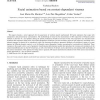Free Online Productivity Tools
i2Speak
i2Symbol
i2OCR
iTex2Img
iWeb2Print
iWeb2Shot
i2Type
iPdf2Split
iPdf2Merge
i2Bopomofo
i2Arabic
i2Style
i2Image
i2PDF
iLatex2Rtf
Sci2ools
CG
2006
Springer
2006
Springer
Facial animation based on context-dependent visemes
This paper presents a novel approach for the generation of realistic speech synchronized 3D facial animation that copes with anticipatory and perseveratory coarticulation. The methodology is based on the measurement of 3D trajectories of fiduciary points marked on the face of a real speaker during the speech production of CVCV non-sense words. The trajectories are measured from standard video sequences using stereo vision photogrammetric techniques. The first stationary point of each trajectory associated with a phonetic segment is selected as its articulatory target. By clustering according to geometric similarity all articulatory targets of a same segment in different phonetic contexts, a set of phonetic context-dependent visemes accounting for coarticulation is identified. These visemes are then used to drive a set of geometric transformation/deformation models that reproduce the rotation and translation of the temporomandibular joint on the 3D virtual face, as well as the behavior...
Articulatory Targets | CG 2006 | Computer Graphics | Phonetic Context-dependent Visemes | Vision Photogrammetric Techniques |
| Added | 11 Dec 2010 |
| Updated | 11 Dec 2010 |
| Type | Journal |
| Year | 2006 |
| Where | CG |
| Authors | José Mario De Martino, Léo Pini Magalhães, Fábio Violaro |
Comments (0)

